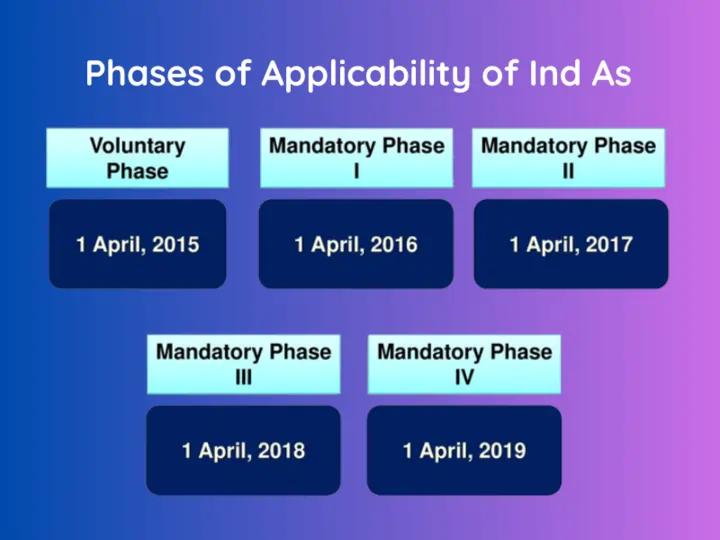Table of Contents
Ind AS i.e. Indian Accounting Standards are a set of accounting standards designed for accounting in different sectors of India. Companies enter the world of Ind AS one phase at a time, based on their net worth and listing status.
Phases of applicability of Ind As:
First of all, we will understand the phased applicability of Ind AS. The Ministry of Corporate Affairs (MCA) has issued a notification outlining the requirement for companies to adopt Ind AS. This adoption is based on a company’s net worth and listing status. The Securities and Exchange Board of India (SEBI) mandates the adoption of Ind As by All listed companies.
To ensure a smooth transition and minimal disruption, the applicability of Ind AS has been divided into four phases. Let us take a closer look at each phase-

Phase 1 (April 1, 2016):
- Securities listed or in the process of being listed on Indian or foreign stock exchanges.
- The net worth of Rs. 500 crores or more.
- Required to implement Ind AS (Indian Accounting Standards).
- This also applies to holding, subsidiary, joint venture, or associate companies.
Phase 2 (April 1, 2017):
- Securities listed or about to be listed on any global stock exchange.
- Net worth less than Rs. 500 crores.
- Mandatory implementation of Ind AS (Indian Accounting Standards)
- This applies to sister companies (subsidiaries, joint ventures, etc.), unless they have their own Ind AS compliance requirements.
Phase 3 (April 1, 2018):
- Net worth between Rs. 250 crores and Rs. 500 crores.
- Not listed or planning to be listed on any stock exchange (Indian or international).
- Mandatory implementation of Ind AS.
- Applies to sister companies (holdings, subsidiaries, etc.), unless they have their own Ind AS compliance obligations.
Phase 4 (April 1, 2019):
- Net worth less than Rs. 250 crores
- Securities not listed or in the process of being listed on any stock exchange (Indian or international).
- Mandatory implementation of Ind AS (Indian Accounting Standards).
- Applies to sister companies (holdings, subsidiaries, etc.) if they are not already required to apply Ind AS.
It is important to remember that the applicability of Ind As also varies depending on the sector. The MCA has mandated certain sectors to become Ind AS compliant while allowing certain exemptions.
Sector-wise applicability of Ind AS:
Mandatory Compliance:
- Banking companies
- Insurance companies
- Non-banking financial companies (NBFCs)
- Listed companies and their subsidiaries
- Unlisted companies and their subsidiaries
- Holding companies, joint ventures, and associates of the above companies
Exemptions Granted To:
- Sole proprietorships
- Partnerships
- Hindu Undivided Families (HUFs)
- Small and medium-sized enterprises (SMEs) If they are not part of the above sectors
- Companies engaged in specialized activities like mutual funds, venture capital funds, and others
Example of Ind As applicability:
Here are two examples to illustrate how Ind AS works, considering both phases and sectors:
Example 1: Phased Applicability
Imagine Company A, a powerhouse in the Indian market:
- It’s a listed company with a net worth of Rs. 750 crores, a true giant in its field.
- When did Ind AS come knocking on its door? Back in Phase 1 (April 1, 2016), as its net worth exceeded the Rs. 500 crore threshold and it was listed.
- Even Company A’s close allies, like its holding, subsidiary, joint venture, or associate companies, had to embrace Ind AS at the same time.
Now, let’s meet Company B, a rising star in its own right:
- It’s an unlisted company with a net worth of Rs. 120 crores, steadily building its presence.
- Ind AS entered its life a bit later, in Phase 4 (April 1, 2019), as its net worth was below Rs. 250 crores and it wasn’t listed yet.
Example 2: Sector-wise Applicability
Company C is a pillar of the banking industry:
- With a net worth of Rs. 150 crores, it plays a vital role in the financial landscape.
- Ind AS compliance was a must for Company C, regardless of its net worth or listing status. Why? Because it operates in the banking sector, which falls under the mandatory compliance category.
On the other hand, Company D is a sole proprietorship with a charming retail store:
- It’s exempt from the Ind AS rules, as sole proprietorships are one of the excluded categories. This means Company D can focus on delighting customers without worrying about Ind AS compliance.
The Ind AS application is done in a phased manner and sector-wise. Apart from this, exemptions have also been given to some sectors, while for some sectors is mandatory to comply with Ind AS. Companies should ensure the applicability of Ind AS to avoid any non-compliance issues.
FAQ:
What are the 4 phases of applicability of Ind AS on business sectors?
Phase I, Phase II, Phase III, and Phase IV.
What are the key financial parameters considered for determining the phases of Ind AS applicability?
The phases of Ind AS implementation are determined based on the company’s net worth, listing status, and business sector.
Are there any exemptions or relaxations provided during the different phases of Ind AS implementation?
Yes, certain exemptions and relaxations are provided for companies transitioning to Ind AS, Like- exemptions related to comparative reporting and certain disclosure requirements.
How does the implementation of Ind AS impact the financial statements of companies?
The implementation of Ind AS significantly impacts the financial statements of companies. This includes changes in accounting policies, recognition, measurement, and presentation of various items like- revenue, leases, financial instruments, and more.
Which is the last phase of Ind As applicability?
Phase IV is the last phase.
What is the rationale behind implementing Ind AS in phases?
Implementing Ind AS in phases allows for a smooth transition and minimizes the disruption to the financial reporting of companies. It also provides sufficient time for businesses to adapt to the new standards.